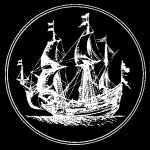
Very little is known about Backhuysen’s early years. Born in the German town of Emden in 1631, he moved to Amsterdam in 1649. The well-educated Backhuysen started his career as an apprentice (bookkeeper and calligrapher) to the famous merchant firm of Bartolotti. His knowledge of geometry, astronomy and navigation made him a great asset to Bartlotti. Backhuysen also taught calligraphy – an art form in which he was particularly proficient – to the sons of rich merchants. His skill as a calligrapher laid the foundations for a successful career. Houbraken (1660-1719), Backhuysen’s biographer in the early eighteenth century, notes that his efforts were soon rewarded. An entry in the marriage register on 30 August 1657, the date of his first marriage, to Lysbeth Lubbers, cites his occupation as ‘tyckenaer’ (draughtsman). His drawings fetched 10, 20, 30 and ultimately 100 guilders apiece, which sharpened his enthusiasm for the work. It was not long before he bade the firm farewell to concentrate solely on art, in particular drawing ships.
As a draughtsman, and later as a painter, Bakhuysen seems to have been largely self-taught. The grisailles (or pen paintings as they are usually called in Dutch) he made in the 1650s show the influence
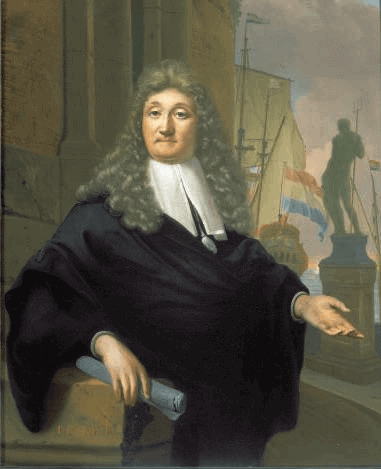
Fig. 1
Portrait of Ludolf Backhuysen (1630-1708)
Oil on canvas, 46 x 37.5 cm
Signed and dated: LBAKH Ft 169(3)
Formerly Rob Kattenburg collection
of Willem van de Velde the Elder (1611-1693) . Impressed by his talent, a number of artists urged him to take up painting in oils. Backhuysen apparently made a habit of visiting painters’ studios, where he learned to look carefully and ask questions. Most of the time thus spent was in the studios of Allaert van Everdingen and
Hendrick Dubbels, though he never stayed in either place long enough to suggest that he was a regular pupil of theirs. Although Backhuysen’s earliest painting is dated 1658, it was not until February 1663 that he was admitted to the painters’ Guild of St Luke.
His reputation as a marine painter must have grown rapidly, for in 1665 the Burgomasters of Amsterdam commissioned him to paint a large view of the harbour of Amsterdam as a gift for Hugues de Lionne, a minister of Louis XIV of France. By the standards of his day, Backhuysen was very well paid, receiving 1,275 florins and a
gold ducat for his wife. Backhuysen’s dignified background and the marriages of several women of standing in his life also contributed to an increase in his fortune and to his ability to attract a wealthy clientele. The fact that he was awarded this important commission proves that he was rated as highly as Willem van de Velde the
Younger, who was still working in Amsterdam at the time. The painting is presently in the Louvre in Paris.
The Van de Veldes were not awarded this commission and found that they suddenly had a formidable opponent to contend with. In all probability, the rivalry between the Van de Veldes and Backhuysen contributed to their decision to set sail for England in the winter of 1672. After their departure he became the foremost marine painter in the Republic.
According to Arnold Houbraken, his fame as an artist was widespread, and among his international clientele he numbered the Grand Duke of Tuscany, the King of Prussia, the Elector of Saxony and several other German princes. Tsar Peter the Great of Russia also seems to have been a great admirer of his work. Backhuysen’s career
as a painter flourished without interruption until his death in 1708. He was a prolific artist and it is not without awe that Houbraken tells us: ‘If it were possible to see all the works of art in one room, one would be astonished by his zeal.’ Some six hundred of his paintings have survived. The figure needs to be revised however, as it is based on a now outdated catalogue by Hofstede de Groot published in 1918.
Backhuysen usually painted on canvas. Much of his work is strikingly large and sizes of 100 x 150 cm and larger are more the rule than the exception. He was singularly inconsistent in spelling his name, sometimes writing CK, sometimes a Y instead of an I. There seems to be a connection between different signatures and certain periods in his career. For instance, from the 1680s onwards he spelled his name with a K only.
His subjects range from seascapes and riverscapes to showpieces based on historical fact or fantasy often featuring colourfully dressed people on board the ships or in the foreground, and he was renowned for his storms and shipwrecks. He painted very few naval battles. His seascapes usually create an atmosphere of high drama, which he articulated with light and dark contrasts to convey narrative and action. In the eighteenth century a stormy sea by Backhuysen – like a ‘calm sea’ by Willem van de Velde the Younger (1633-1707) – was seen as essential in any collection of Dutch paintings. As well as marines, he made a number of portraits and the occasional allegory and townscape. He also left drawings and engravings.
Backhuysen was a keen student of nature, interested in meteorological phenomena and their impact on human enterprise. It seems likely that he repeatedly went out on his ‘boeier’ to study the movement of the water, since this type of ship is frequently depicted in his paintings and drawings. His compositions, which are numerous, are nearly all variations of one subject, the sea, and in a style peculiarly his own, marked by intense realism or faithful imitation of nature. His career reflects a constant endeavour to capture the movement of light and water in dynamic compositions with bold contrasts in form, colour and light.
Although from a historical viewpoint Backhuysen seems less accurate than the Van de Veldes, there is nothing wrong with the way he depicts the ships. It is clear from his paintings that he understood the different types of ships, and they lie convincingly in the water. Sails and rigging are rendered faultlessly. One only has to look at the work of lesser marine painters to realise just how difficult it is to depict this subject realistically and convincingly.
Backhuysen’s artistry was not confined to technical mastery. Artistically he was on a level with the best, and his greatest works – of which there are quite a few – harmoniously combine an atmospheric quality, a wonderfully luminous colour scheme and a happy composition, and are on a par with the best of Willem van de Velde the Younger’s paintings.
As in the case with almost every successful painter, the great demand for his paintings inevitably led to the occasional loss of quality, and routine tended to creep in. However, many works remain to fully justify his reputation as one of the best marine painters Holland has ever known, as can be seen in some of the great museums
of the world, such as the Rijksmuseum and the Amsterdam Museum in Amsterdam, the National Maritime Museum in Greenwich, the National Gallery in London and the Louvre in Paris.
As an artist of superior standing Backhuysen had a considerable influence on his contemporaries and later generations. Some of the Van de Veldes from the 1670s have been mistaken for Backhuysens. He greatly influenced a group of marine painters which included Jan Claesz Rietschoof , Hendrick Rietschoof, Michiel Maddersteg, Jan
Theunisz Blanckerhof , Aernout Smit and Wigerius Vitringa. None of these artists achieved the technological and artistic proficiency of Ludolf Backhuysen. Although he is not known to have been his pupil, Abraham Storck was also influenced by Backhuysen.
Later generations of marine painters, such as J.C. Schotel, still turned to him for inspiration. Drawings by J.C. Schotel are still sometimes wrongly attributed to Backhuysen. Even Nicolaas Baur, who was highly praised in his time, was strongly influenced by Backhuysen around the year 1800.
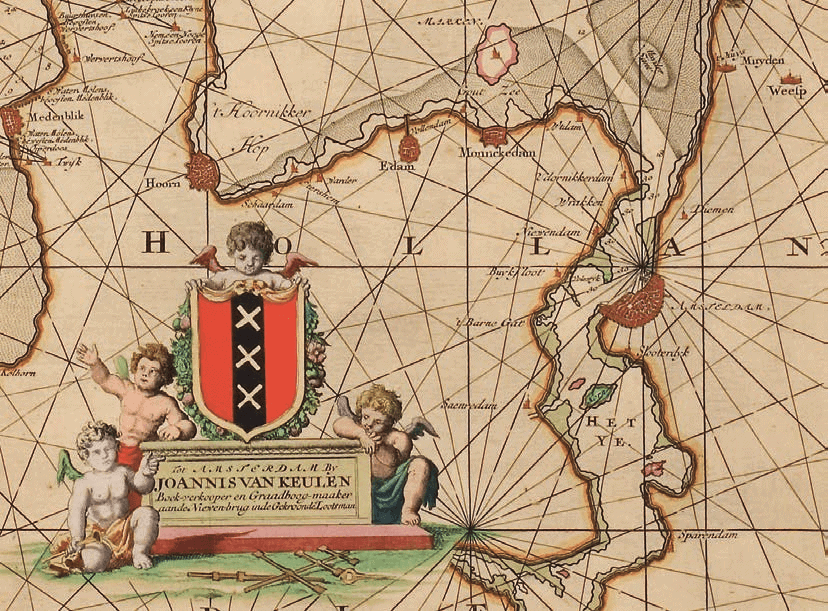
Viewpoint of Ludolf Backhuysen,
looking from Nieuwendam to
Amsterdam
Fig. 2
Johannes van Keulen I
Paskaarte van de Zuyder Zee met
alle des Zelfs inkomende Gaaten
So als die op ’t Zeekerts konnen
bezeylt worden : naa Haare
Courekte Course, Opdoeningen,
Droogten, en Diepten
Cloured engraving on paper,
51 x 57 cm
From the ‘Zee-Atlas ofte Waterwerelt’; Amsterdam, circa 1680
Rotterdam, Maritiem Museum,
inv. no. WAE696
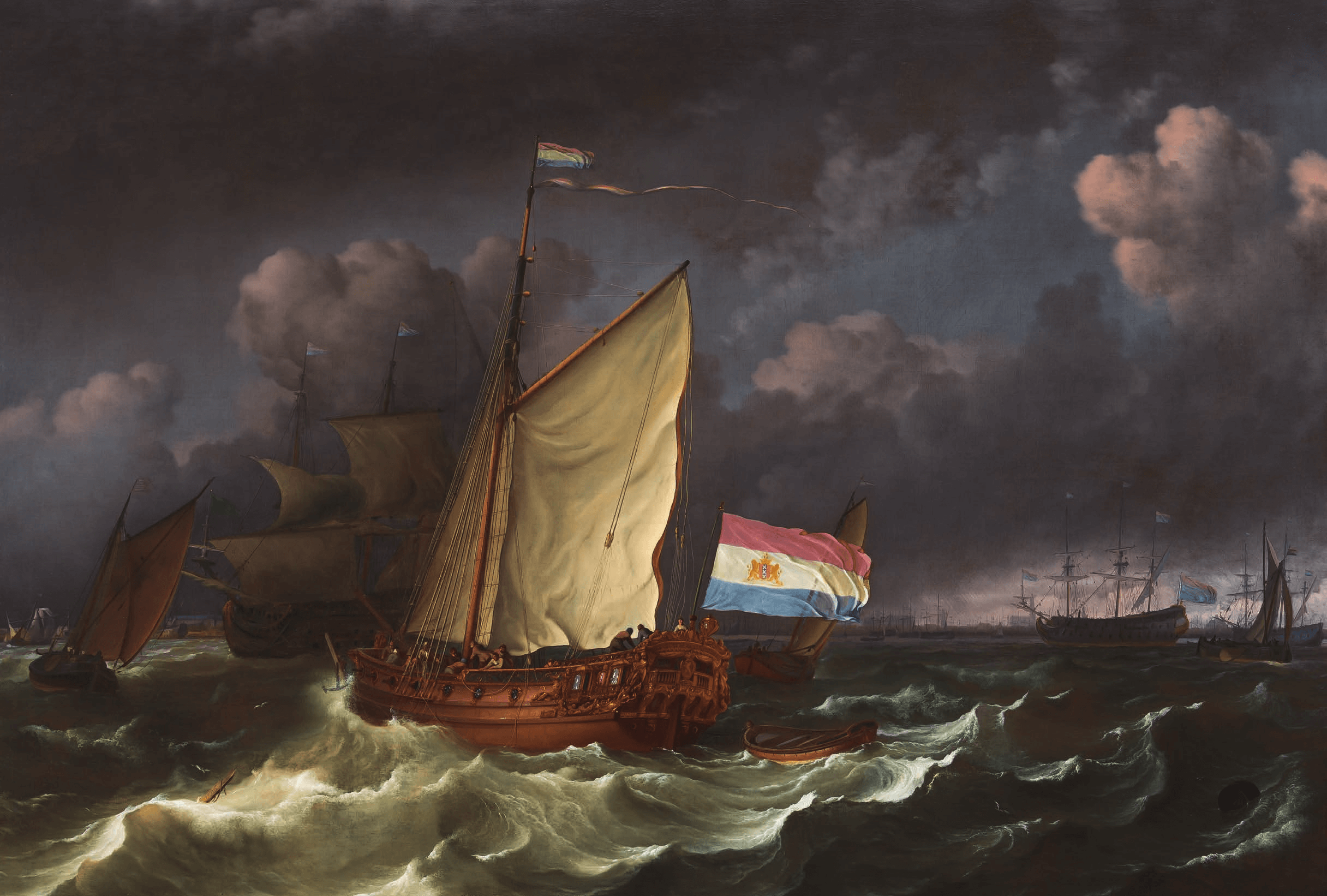
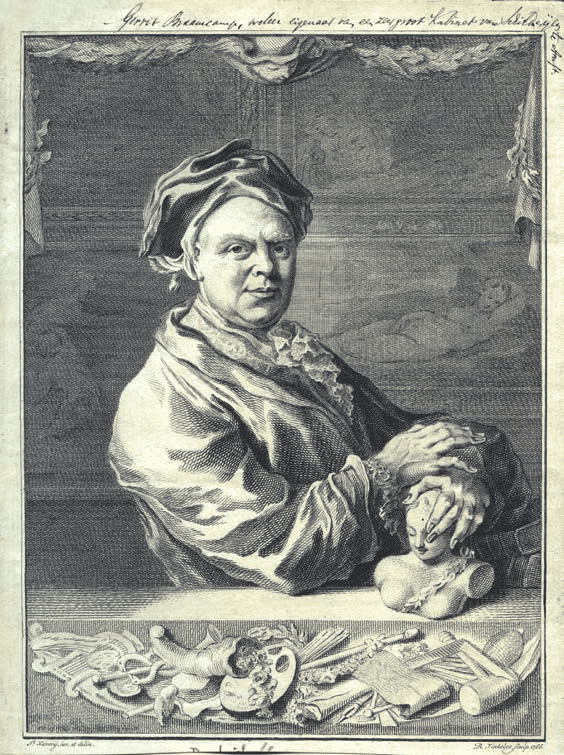
Fig. 4
G. Vinkeles
Etching, 1766
Portrait of Gerret Braamcamp, formerly the owner of a very great
collection of paintings in Amsterdam
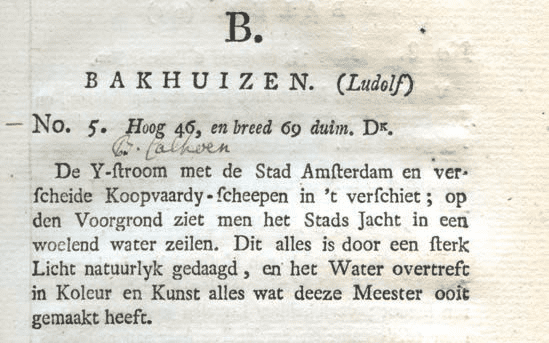
Fig. 6
Third page of the 1771 auction catalogue of the great collection of
Gerret Braamcamp. Backhuysen’s seascape is listed under no. 5
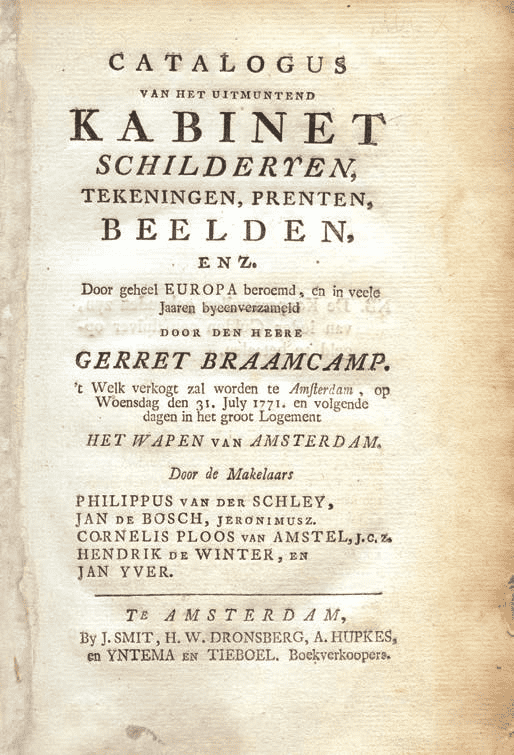
Fig. 5
Frontispiece of the 1771 auction catalogue of the great
collection of Gerret Braamcamp
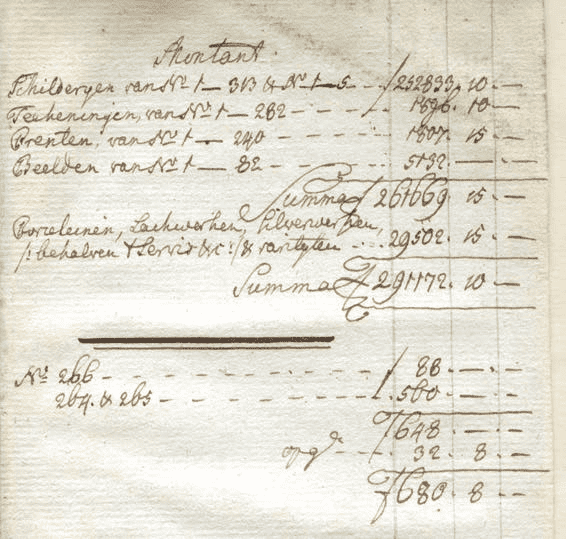
Fig. 7
Annotated page in the 1771 auction catalogue of the total proceeds
of the collection of Gerret Braamcamp
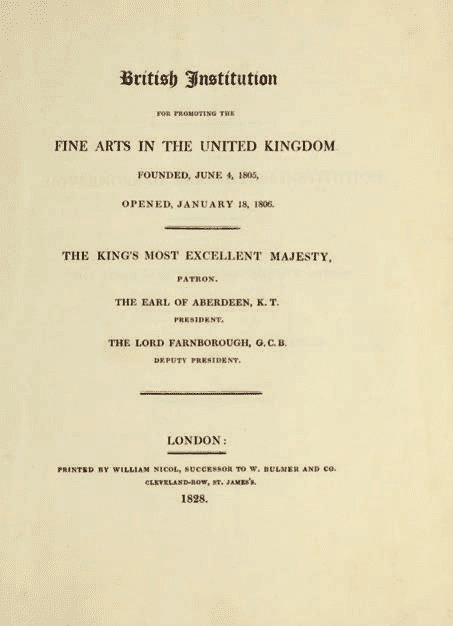
Fig. 8
Title page of the British Institution for Promoting the Fine Arts in the United Kingdom: Catalogue of pictures by Italian, Spanish, Flemish, and Dutch masters of the British Institution for Promoting the Fine Arts in the United Kingdom, London 1828.
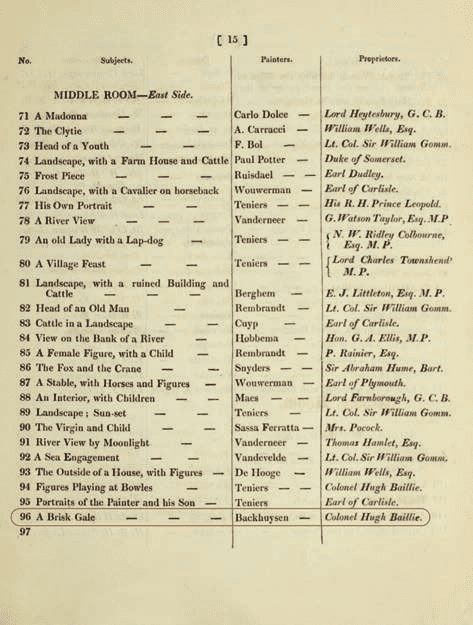
Fig. 10
The painting by Backhuysen was listed as ‘A Brisk Gale’ under
cat.no. 96 in the London exhibition catalogue of 1828
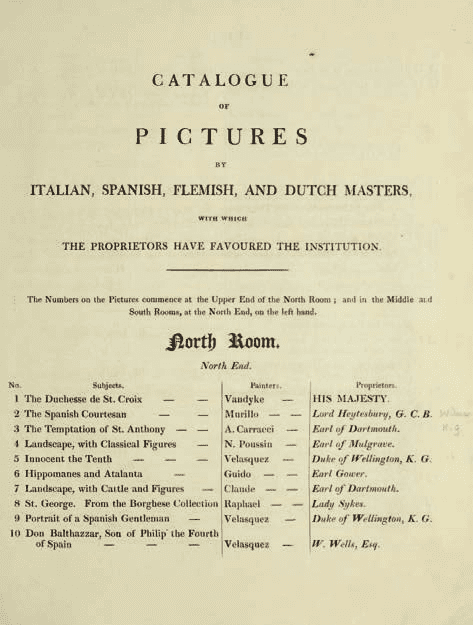
Fig. 9
Introduction page of the exhibition catalogue of pictures by Italian, Spanish, Flemish, and Dutch masters of the British Institution for Promoting the Fine Arts in the United Kingdom, London 1828.
The Backhuysen was cat. no. 96.
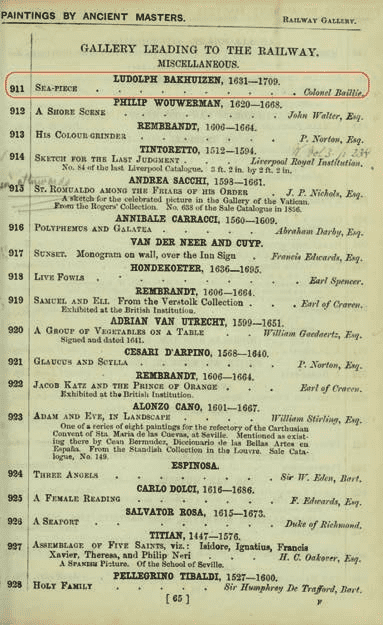
Fig. 11
Page 65 of the exhibition catalogue of the art treasures of the
United Kingdom collected at Manchester in 1857. The Backhuysen
is listed under cat. no. 911 as ‘A Sea Piece’
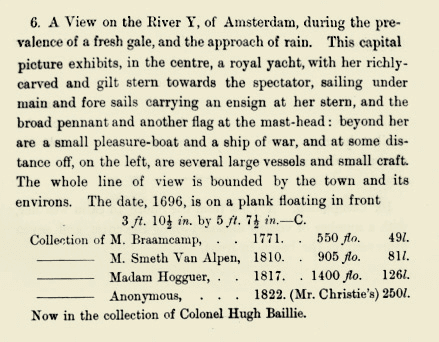
Fig. 12
John Smith’s A Catalogue raisonné of the Works of the most eminent Dutch, Flemish, and French painters, London 1835, vol. VI,
p.p. 406-407.
Backhuysen’s seascape is annotated and listed under no. 6 as ‘This capital Picure’.

Fig. 13
Frontispiece of C. Hofstede de Groot, A Catalogue raisonné of the Works of the most eminent Dutch painters of the seventeenth century. Based on the work of John Smith. London 1923, vol. VII.
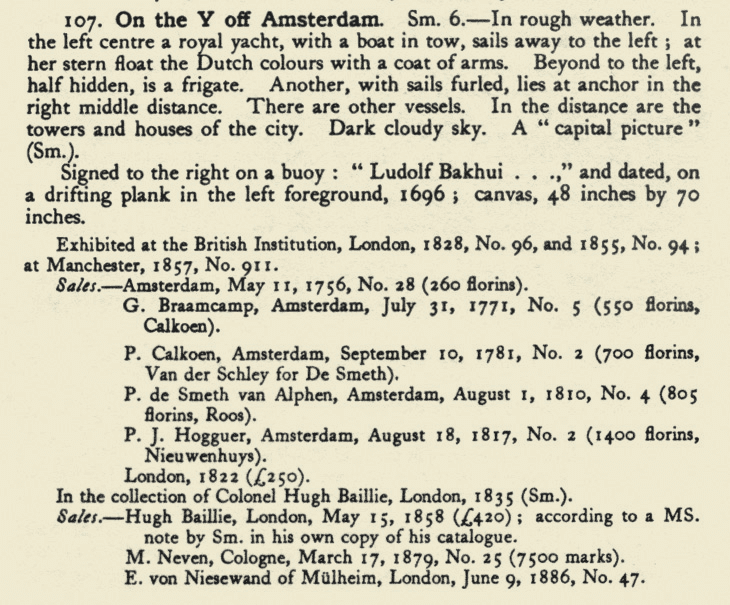
Fig. 14
C. Hofstede de Groot, A Catalogue raisonné of the Works of the most eminent Dutch painters of the seventeenth century. Based on the work of John Smith. vol. VII.
London 1923, pp. 239 240.
Backhuysen’s seascape is listed under no. 107 as ‘ A capital Picure’. (Sm.)
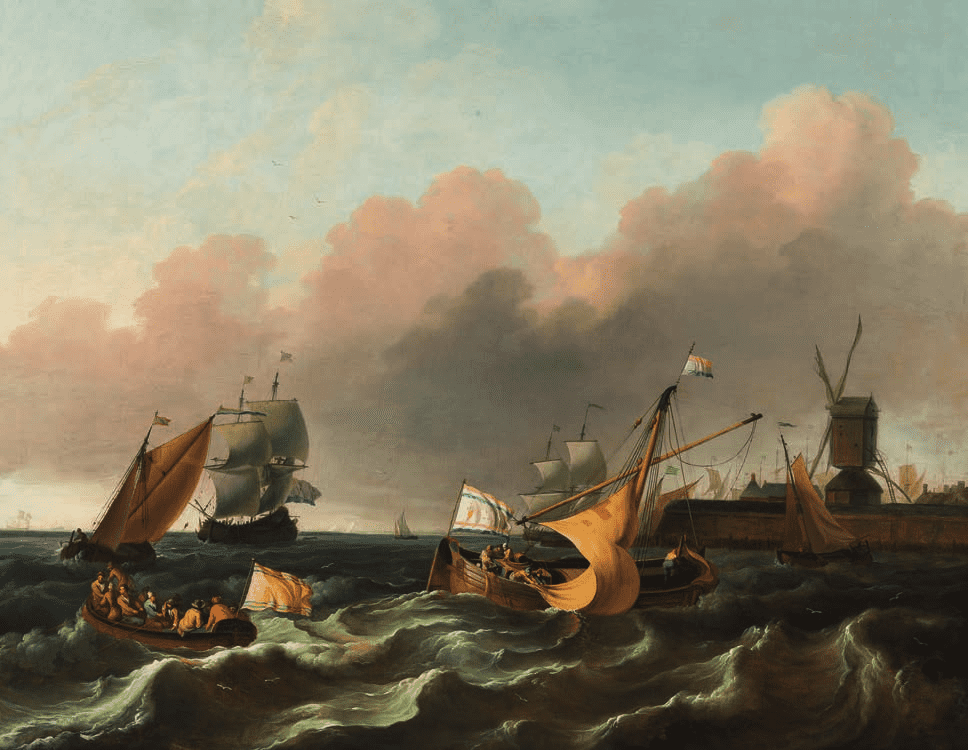
Fig. 15
Ludolf Backhuysen,
Ships on de IJ river (Amsterdam) off the Leeuwenberg jetty and the
windmill ‘De Bok, also called ‘BLAUHOOFD’
Oil on canvas: 64 x 77 cm
Signed with initials on the flag l.c. : L.B.: Y
Indistinctly signed and dated on the barrel l.r.: L Ba.h /1704
Rob Kattenburg Collection
Ludolf Backhuysen
Two etchings from the complete set of etchings by L. Backhuysen:
“D’Y stroom en Zeegezichten”/ getekent en geëtst door
LUDOLF BAKHUIZEN/ Anno 1701 In Amsterdam
Rob Kattenburg Collection
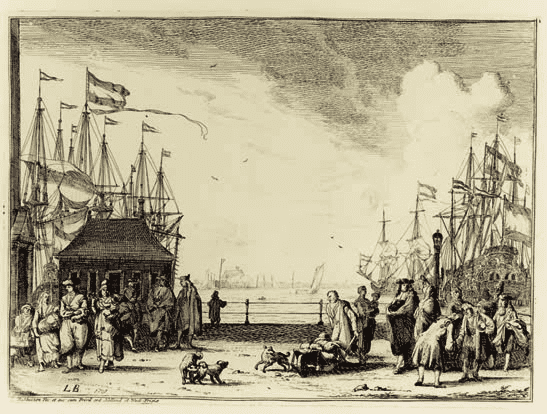
Fig. 16
View across the IJ to the North at the New City Inn
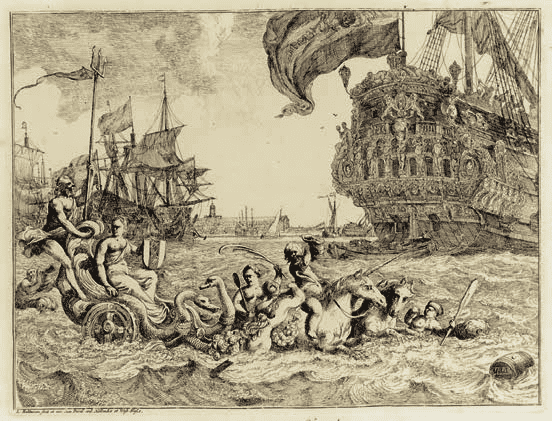
Fig. 17
The personification of the city of Amsterdam on a triumphal car
on the IJ
ACKNOWLEDGEMENTS
Production and research Rob Kattenburg
Text Saskia Kattenburg
Printing Die Keure, Bruges
Typesetting Holger Schoorl
Photo credits
pp. 6-7, 11 and cover, Pieter de Vries, Texel
p. 3 Rotterdam, Maritiem Museum
This catalogue is published by Rob Kattenburg BV, 2018
Rob Kattenburg
Eeuwigelaan 6
1861 CM Bergen (NH)
The Netherlands
Tel. +31 (0)72 589 50 51
Fax +31 (0)72 581 6031
[email protected]
www.robkattenburg.nl
By appointment only
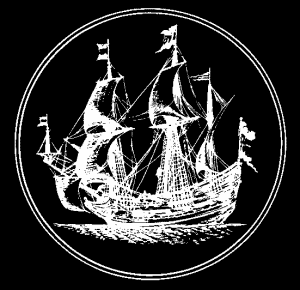
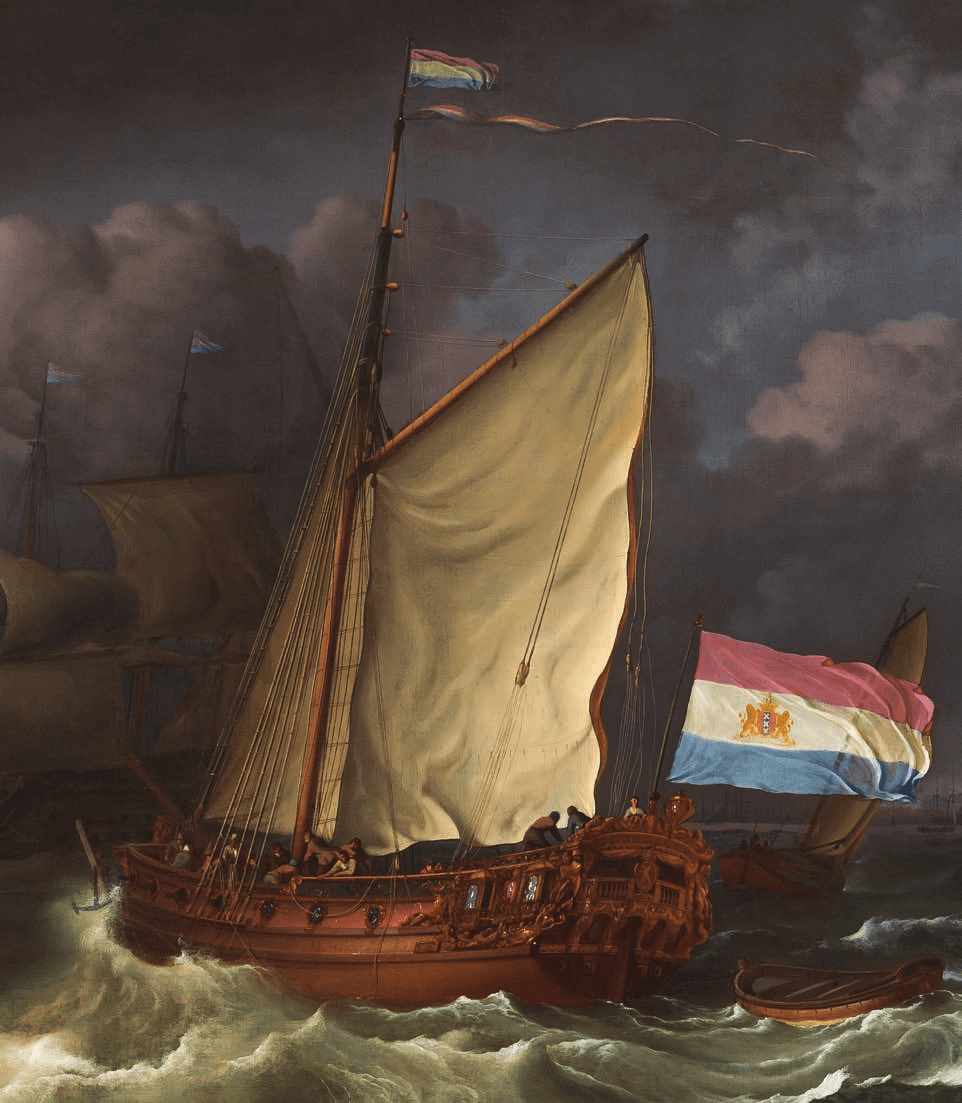
Oil on canvas: 117 x 173 cm.
Signed lower right on the barrel: Ludolf / Bakhui
Dated on a spar lower left: 1696
Provenance:
– Sale Amsterdam, May 11, 1756, No. 28
– Amsterdam, collection Gerret Braamcamp (1699-1771)
– Sale, Amsterdam, Schley etc., July 31, 1771, No. 5 (fl. 550 to Pieter Willemsz Calkoen, 1712-1780)
– Sale, Amsterdam, Schley, September 10, 1781, No. 2 (fl. 700, to Van der Schley, for Pieter de Smeth van Alphen (1753-1809)
– His deceased sale, Amsterdam, Schley, August 1, 1810, No. 4 (fl. 805, to Cornelis Sebille Roos, 1754-1820)
– Sale Amsterdam, Schley (Paul Iwan Hogguer), August 18, 1817, No. 2 (fl. 1400 to Lambert Jan Nieuwenhuys)
– Collection Christian Josi (1768-1828)
– Sale London, Christie’s (Josi), March 23, 1822, No. 63 (£ 262.10, to Colonel Hugh Duncan Baillie, 1777-1866)
– Sale London, Christie’s (Baillie), May 15, 1858, No. 26 (£ 420)
– Sale Cologne, M. Neven, March 17, 1879, No. 25 (7500 Marks)
– Sale London, E. von Niesewald of Mülheim, June 9, 1886, No. 47
– Sale Stockholm, Bukowskis, June 1, 2006, No. 1290
– Stockholm, private collection
Exhibited:
– London, The British Institution 1828, No. 96
– London, The British Institution 1855, No. 94
– Manchester, Exhibition of the art treasures of the United Kingdom 1857, No. 911
Literature:
– CATALOGUS VAN HET UITMUNTEND KABINET SCHILDERYEN, PRENTEN, BEELDEN, ENZ. Door geheel EUROPA beroemd, en in veele Jaaren byeenverzameld DOOR DEN HEERE GERRIT BRAAMCAMP. (Auction catalogue) Amsterdam 1771, p.3, no. 5 (as ‘De Y-stroom met de Stad Amsterdam en verscheidene Koopvaardy-scheepen in ’t verschiet; op den Voorgrond ziet men het Stads Jacht in een woelend water zeilen. Dit alles is door een sterk Licht natuurlijk gedaagd, en het Water overtreft in Koleur en Kunst alles wat deeze Meester ooit gemaakt heeft’).
– De Kunstverzameling nagelaten door de Heer PIETER CALKOEN WILLEMSZ, te Amsterdam 1781, no. 2, (Auction catalogue).( as ‘Ce Tableau represente la Vue de l’Y. On y remarque, a l’horizon, des Vaisseaux Marchands, devant la ville d’Amsterdam. Sur le devant, on distingue une Eau agitée, agréablement éclairée par un beau Soleil ; on y voit le Yacht des Etats, qui semble vouloir passer derriere un Vaisseau à trois Mâts, qui est à la Voile, & de plus differents autres Bâtiments. Ce Tableau produit un effet surprenant par l’harmonie qui y regne ; l’Eau y est representée d’un transparent admirable. Ce morceau surpasse tout ce qui est connu de ce Maitre’).
– Catalogus van het Kabinet van Schilderijen, nagelaten door Den Hoog Edelen Gestrengen Heer Mr. Pieter de Smeth van Alphen. Groot Kruijs van de Koninklijke Orde des unie, Staatsraad van Zijne Majesteit den Koning van Holland, en Vroedschap van Amsterdam, (Auction catalogue) Amsterdam 1810, lot no. 4 (as ‘Een woelend Water; zijnde een Gezigt in het IJ, met een groot Jagt, bij den Wind zeilende, verder Oorlogschepen, andere Vaartuigen en de Stad Amsterdam in het verschiet [Vue sur le Port d’Amsterdam, le Fleuve l’IJ étant agité. On y distingue un Jacht voilant sous le vent ; plus en arriere se trouvent des Vaisseaux de guerre et d’autres Batiments ; la Ville d’Amsterdam se presentant dans la perspective]’).
– Catalogus van het uitstekende kunstkabinet van kostbare schilderijen, teekeningen, prenten, beeldwerk, in marmer, ivoor, metaal, hout enz. schilderwerk in miniatuur en op glas; amaille, agaat, mosaiek, barnsteen, schildpad, en andere keurige en zeldzame rariteiten; alsmede fraaije penningen, munten, enz. alles bijeenverzameld door
vrouwe Anna Maria Ebeling, in leven echtgenote van Jonkheer Iwan Hogguer, Burgemeester dezer stad enz. enz. (Auction catalogue) Amsterdam 1817, lot nr. 0002 (as ‘Dit kostbaar schilderij stelt voor een gezigt op de stad Amsterdam uit het Ij te zien; op den voorgrond is het woelende water gestoffeerd met het stads jagt, achterwaarts een zeilend oorlogschip en kleindere vaartuigen; ter regter zijde, digt voor en in de laag der stad, ziet men nog meerder schepen. Het water is dun, en de golving allernatuurlijkst voorgesteld, zijnde een der kapitaalste stukken van dezen voorbeeldeloozen zeeschilder’).
– Collection Christiaan Josi, (Auction catalogue) London 1822, lot no. 63,(as ‘ View of the Port of Amsterdam; in front the State Yacht under orders, is seen on the tack, to loof alongside a Man of War under weigh in squally weather; a part of the Dockyard and City is seen in the distance. This capital Picture having successively
adorned the renowned cabinets of Braamcamp, Burgomaster Calkoen, de Smeth, and lastly that of Hoguer, at Amsterdam, has been universally allowed by the best judges, as the happiest effort of the genius of the Master, who certainly never has produced a more striking effect of nature, nor has expressed the motion of his figures, and of the water, with such illusion as he has done in this piece, the excellence of which is equalled by its high state of preservation’).
– British Institution for Promoting the Fine Arts in the United Kingdom : Catalogue of pictures by Italian, Spanish, Flemish,
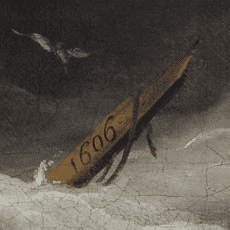
The date, detail of fig. 3
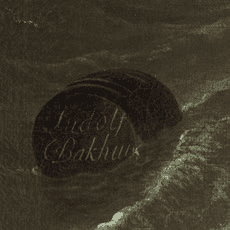
Signature, detail of fig. 3
and Dutch masters : with which the proprietors have favoured the Institution, London 1828, p. 15, cat. no. 96.
– J. Smith, A Catalogue Raisonné of the Works of the Most Eminent Dutch, Flemish, and French Painters, vol. VI, London 1835, pp. 406-07, no. 6 (as ‘A view on the River Y, of Amsterdam, during the prevalence of a fresh gale, and the approach of rain. This capital picture exhibits, in the centre a royal yacht, with her richly carved and gilt stern towards the spectator, sailing under main and fore sails carrying an ensign at the stern, and the broad pennant and another flag at the mast-head: beyond it are a small pleasure boat and a ship of war, and at some distance off, on the left, are several vessels and small craft. The whole line of view is by the town and its environs. The date, 1696, is on a plank floating in front’).
– Catalogue of the art treasures of the United Kingdom collected at Manchester in 1857, London 1857, p. 65, cat. no. 911
– C. Hofstede de Groot, A Catalogue raisonné of the Works of the Most Eminent Dutch Painters of the Seventeenth Century: Based on the Work of John Smith, vol. 7, London 1923 (ed. Cambridge 1976), pp 239-40 (as ‘In rough weather. In the left centre a royal yacht, with a boat in tow, sail away to the left; at her stern float the Dutch colours with a coat of arms. Far left, a half-hidden frigate. Another, with sails furled, lies at anchor in the right middle distance. There are other vessels. In the distance are the towers and houses of the city. Dark cloudy sky. A “capital picture”.’)
THE PAINTING
A very rare view of Amsterdam from the village of Nieuwendam across the Y with the City of Amsterdam’s yacht, masterfully executed, in the middle. In the distance we see the skyline of Amsterdam. From left to right: ‘T Oost Indische Zeemagazijn’ and the ‘Scheeps-Timmer-Werf ’ (Dutch East India Company wharf ), next to the yacht a conglomeration of ‘t Stadhuys’ or the Town Hall, now the Royal Palace and the Nieuwekerk, the Haringpakkerstoren, the Westerkerk and the Noorderkerk.
The heavy traffic on the water is seen from the north bank of the IJ and the Amsterdam skyline of is visible in the background. On the left we see a boeier and a three-decker hauling in its sails before the upcoming storm. An ominous sky darkens the scene. Only the yacht in the middle of the picture catches the last light, whilst the white-crested waves gain strength. The sumptuous and elaborately decorated yacht flies the tricolour of the City of Amsterdam at her stern. The pennant on the mainmast signifies that a dignitary is on board. Beside the yacht we see a boeier with several ships lying at anchor in the background. On the far right a Dutch three-decker lies at anchor with sails furled, with a wijdtship and a fluit with armament.
The dynamic style that distinguishes Backhuysen’s work and places him head and shoulders above most other marine painters is evident in this painting. From the outset, he had a talent for depicting a logical sequence of events. The yacht’s light-coloured sail stands in contrast to the dark outline of the man-of-war at the rear
and the dark surface of the sea. As the ominous clouds gather for the upcoming storm, a beautiful white light illuminates the waves around the yacht. This near-theatrical lighting is characteristic of Backhuysen’s work and he exploited chiaroscuro contrasts to superb effect in this scene. The three-masters at anchor and the other ships in the right background lend balance to the composition. The painting A View of Amsterdam with Ships on the River IJ, in the Middle the Elaborately Decorated City Yacht is superbly executed; the convincing way in which the ships and the atmosphere are rendered is particularly noteworthy. The painting, with its beautiful yacht prominently displayed, was undoubtedly commissioned by the City of Amsterdam.
THE YACHT
The date, detail of fig. 3 Signature, detail of fig. 3 The City Yacht. Detail of fig. 3 The name of the yacht is derived from the Dutch word ‘jagen’ or ‘jacht maken’, which means to hunt or to pursue. This light fast sailing vessel is known from the 16th century onwards and were used by sailors from Dunkirk, Zeeland and Holland. These armed yachts were used for intercepting larger and slower ships and the precursors of the yachts which were permanently equipped for war. On account of its usefulness, the yacht was used for the delivery of messages, commands and the transportation of dignitaries.
In the 17th century this type of yacht developed into much bigger vessels and some could be even more than a hundred tons. Soon after there came a division in lighter and heavier ships. We can subdivide the different types of yachts which were used by the VOC (East-India Company) and WIC (West India Company), the ones which were also part of the war fleet and the so called ‘Statenjacht’ or States Yacht.
The States Yacht, was the general name for yachts which were used for the transportation of dignitaries, such as princes, hence the name ‘Prinsenjacht’. During the reign of the ‘Stadhouders’ the ‘Prinsenjacht’ was a service vessel for the performance of their duties and was owned by the admirality. The same type was soon be used
by the members of the Admiralties, the States, the City Councils, the VOC, WIC and so on. There were ‘Adviesjachten’, ‘Stadsjachten’ ‘Speeljachten’ and ‘Herenjachten’. During the 17th century the yacht became a pleasure craft used first by royalty and later by the burghers on the canals and the protected and unprotected waters of the Low Countries.
These vessels were usually affluently decorated with sculptures, paintings and gilding following the tradition of the great sailing ships. In the 18th century the ‘Statenjacht’ was also used as a pleasure craft.
In this painting by L. Backhuysen the beautifully decorated ‘Stadsjacht’ (City Yacht) of around 1696 is shown on the turbulent waters of the IJ with the skyline of Amsterdam in the background. Undoubtedly, the City Council must have commissioned the painting with the ‘Stadsjacht’ prominently displayed. Catching the light, it sails towards the eastern islands of the city where the ‘T Oost Indische Zeemagazijn’ and the ‘Scheeps-Timmer-Werf’ (Dutch East India Company wharf) were situated. The 188 m² Zeemagazijn was built between 1662 and 1664 to a design by Daniël Stalpaert (1615-1676) and since then has been the symbol of Amsterdam’s maritime power.
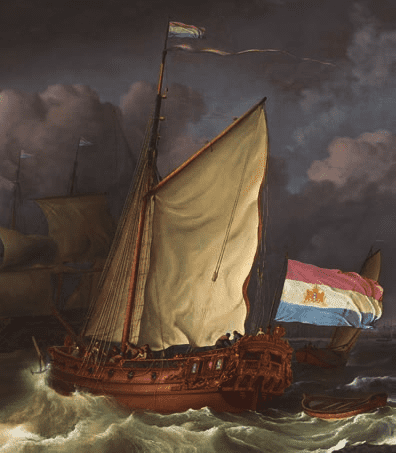
The City Yacht. Detail of fig. 3
© 2022 Rob Kattenburg
Website Mediya.nl